Imagine a hot, sunny day, and you’re craving something light, refreshing, and packed with flavor. A watermelon salad is the perfect choice! This delicious dish combines juicy watermelon with a variety of other ingredients, creating a harmony of taste and texture in every bite. Follow along as we guide you through the process of finding the perfect recipe, selecting your ingredients, and mastering the art of watermelon salad preparation.
Finding a Watermelon Salad Recipe
Begin by searching the internet for watermelon salad recipes. You can use popular search engines like Google, Bing or Yahoo to conduct your search. Type in keywords such as “watermelon salad recipe,” “watermelon feta salad,” or “watermelon mint salad” to find specific variations.
Visit trusted food websites, blogs, or online magazines dedicated to sharing healthy and delicious recipes. Some popular websites include Allrecipes, Food Network, Epicurious, Tasty, and Food52.
Look for websites with user reviews and ratings for their recipes. Reading reviews can give valuable insights into the taste and preparation of the dish, especially if you are trying a new recipe.
When you find a recipe that appeals to your taste, read through the list of ingredients to ensure you have everything or can substitute missing ingredients. The list will include items such as watermelon, greens, cheese (typically feta), herbs such as mint or basil, and dressing ingredients, like olive oil, lemon juice, or vinegar.
Review the measurements of each ingredient to ensure you understand the quantities needed to make the salad. Measurements are typically given in cups, tablespoons, or grams, depending on the recipe. Make sure to follow the measurements accurately to achieve the desired flavor and balance in your salad.
Carefully read the instructions provided in the recipe, including preparation, chopping and mixing methods. Some recipes may require the watermelon to be cut into cubes, while others may call for melon balls or thin slices. Ensure you understand the instructions before proceeding with the recipe.
Make a shopping list of the ingredients you need, ensuring you purchase only fresh, ripe, and high-quality ingredients, such as a seedless watermelon, for the best possible taste.
Assemble all the necessary utensils and tools required to make the salad, such as a cutting board, knife, melon baller, vegetable peeler, measuring cups and spoons, mixing bowls, and serving plates.
Finally, prepare the watermelon salad recipe according to the instructions provided, adjusting the dressing, herbs, or seasoning according to your taste preferences.
Once your watermelon salad is ready, serve and enjoy it as a refreshing appetizer or side dish during hot summer days.

Selecting a Watermelon and Other Ingredients
Selecting a ripe and juicy watermelon:
-
Look for a firm and symmetrical watermelon: Make sure the watermelon does not have any flat sides, irregular bumps, or dents. This indicates that the fruit has evenly ripened.
-
Check for a creamy-yellow spot: This is the spot where the watermelon was sitting on the ground while ripening. A ripe watermelon will have a creamy-yellow color spot. If it’s white or does not have any spot, it may not be ripe.
-
Look for a uniform color: Choose a watermelon with a dark green and uniform color, without any stripes or spots.
-
Size matters: Pick a watermelon that is neither too big nor too small. Instead, look for a fruit that feels heavy for its size. This indicates that there is plenty of water and sugar, making it ripe and juicy.
-
Knock on it: Gently tap the watermelon with your knuckles. A ripe watermelon will have a deep, hollow sound. If it sounds dull or flat, it may not be ripe yet.
Selecting the right ingredients to go with your watermelon salad:
-
Feta cheese: Look for a good-quality feta cheese, preferably made from sheep or goat milk. It should be creamy and slightly tangy. You can also opt for a low-fat or vegan version if desired.
-
Cucumber: Choose crisp and firm cucumbers without any blemishes, and avoid those that are overly ripe or have soft spots.
-
Mint leaves: Fresh mint leaves are essential in a watermelon salad. Look for bright green leaves without any dark spots or wilting.
-
Red onion: Opt for a medium-sized red onion with a smooth, shiny skin. Make sure it feels firm and has no soft spots.
-
Olive oil: Use a high-quality extra virgin olive oil for a balanced and flavorful taste.
-
Lime or lemon: Get a fresh and firm lime or lemon with a smooth skin. Make sure it does not have any soft spots or blemishes.
-
Salt and pepper: Freshly cracked black pepper and a pinch of sea salt or kosher salt will enhance the flavor of the salad.
Optional ingredients:
-
Balsamic glaze: You can drizzle some balsamic glaze on the salad for an extra touch of sweetness.
-
Arugula or mixed greens: For a more substantial salad, add some fresh arugula or mixed greens for an extra crunch.
-
Toasted almonds or walnuts: For added texture, consider incorporating some toasted almonds or walnuts into your salad.
Now that you have selected a ripe watermelon and the accompanying ingredients, you’re ready to make a delicious watermelon salad. Enjoy!
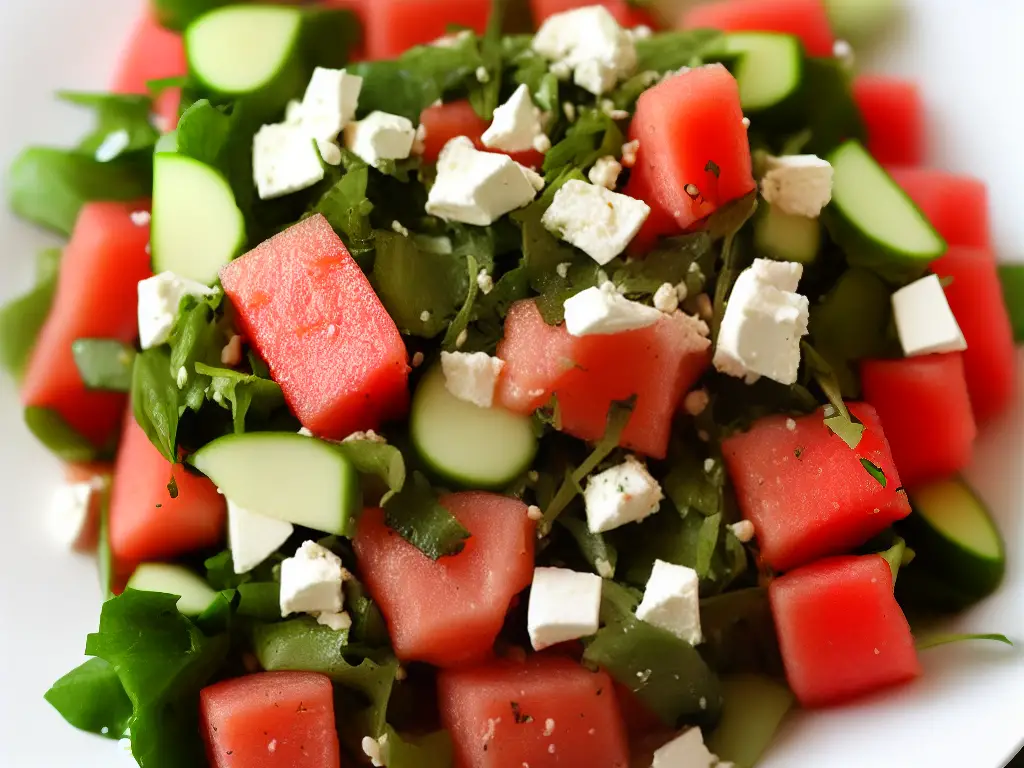
Preparing the Watermelon
Step 1: Choose a ripe watermelon
Select a watermelon that has a uniform shape, is free from any flat sides or dents, and feels heavy for its size. Look for a white or yellowish spot on the watermelon where it has been sitting on the ground, known as the sugar spot. This indicates it is ripe and sweet.
Step 2: Gather your tools
You’ll need a cutting board, a sharp knife (preferably a chef’s knife or a serrated knife), a spoon, and a large bowl.
Step 3: Wash the watermelon
Clean the surface of the watermelon with water and pat it dry.
Step 4: Cut off the ends
Slice off a small part of both ends of the watermelon to create a flat surface, which will help keep the watermelon stable while cutting.
Step 5: Remove the rind
Stand the watermelon on one of the flat ends. Use your knife to carefully slice off the rind from top to bottom, following the curve of the watermelon. Continue removing the rind, making sure to cut away any remaining white parts as they can be tough and less flavorful.
Step 6: Cut the watermelon in half
Place the watermelon on its side and slice it in half so you have two semi-circle pieces.
Step 7: Quarter the watermelon
Take each half of the watermelon and slice it in half again, resulting in four quarters.
Step 8: Remove the seeds
Using a spoon or the tip of your knife, remove any visible black seeds from each watermelon quarter. Some watermelons may have small white seeds which are edible, but you may choose to remove them as well.
Step 9: Slice the watermelon into strips
With the flesh side up, cut each quarter into 1-inch strips, cutting perpendicular to the length of the watermelon.
Step 10: Cube or chunk the watermelon
Now, cut across the strips to create 1-inch cubes or chunks. Adjust the size of the cubes or chunks to suit your preference for the salad.
Step 11: Collect and store the watermelon
Place the watermelon cubes or chunks in a large bowl. If not using right away, cover the bowl with plastic wrap and refrigerate until needed.
Now that you have prepared, cut, and deseeded the watermelon, you’re ready to make a delicious watermelon salad. Simply mix the watermelon chunks with other fruits, vegetables, herbs, and seasonings of your choice to create a refreshing and healthy dish. Enjoy!
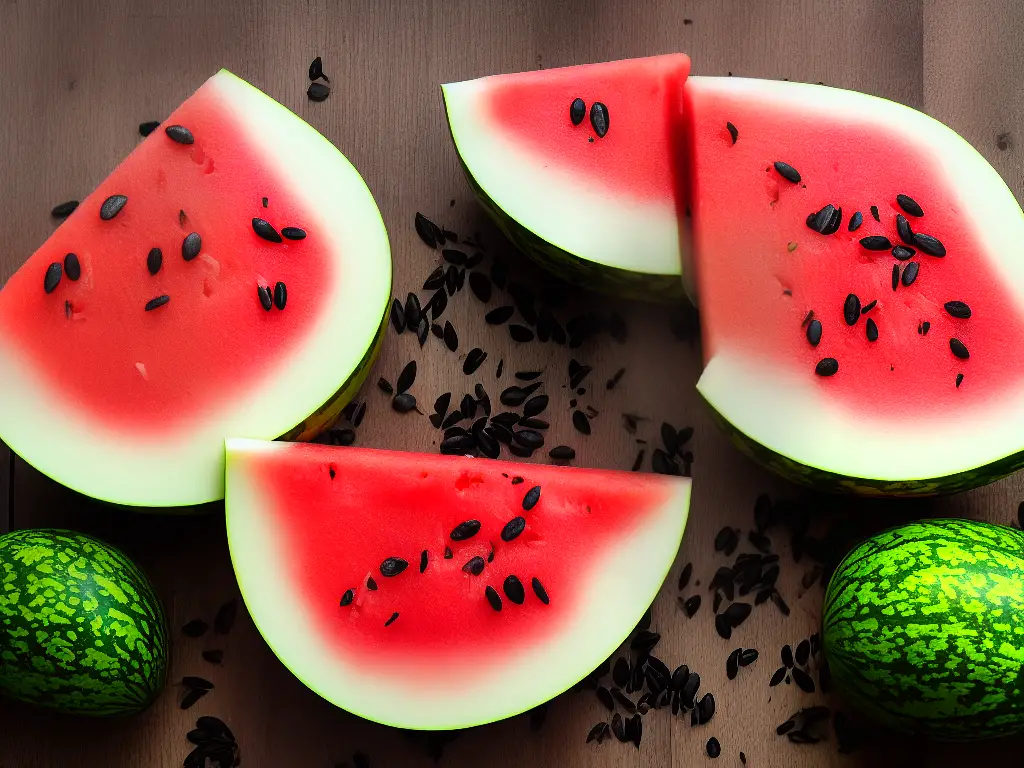
Prepping Other Salad Ingredients
Here are the instructions to prepare a watermelon salad with other salad ingredients like vegetables, fruits, and herbs. This guide will help you learn how to wash, chop, and combine those ingredients for a delicious, fresh watermelon salad.
1. Gather your materials and ingredients:
- Cutting board
- Chef’s knife
- Colander
- Salad spinner (optional)
- Large mixing bowl
- Cucumbers
- Red onion
- Feta cheese
- Mint
- Basil
- Lime juice
2. Wash your hands:
Before starting any food preparation, always wash your hands thoroughly with soap and water.
3. Prepare your watermelon:
- Wash the watermelon under cold running water using a vegetable brush.
- Dry it and cut off the ends and carefully remove the rind around the flesh.
- Cut the watermelon into small triangles or bite-size cubes, ensuring no seeds are present.
4. Prepare other fruits and vegetables:
- Rinse any fruits and vegetables under cold running water.
- Using a knife, cut off any unwanted parts and chop each ingredient into bite-sized pieces
5. Soak and rinse herbs:
- Place fresh herbs, such as mint or basil, into a colander and shake under cold running water to remove any dirt or debris.
- Gently pat the herbs dry with a clean paper towel.
6. Chop herbs:
Finely chop the herbs with your chef’s knife, rocking the blade back and forth while keeping one hand on the handle and the other on the tip. This will ensure a finely chopped, even texture.
7. Combine ingredients:
Place everything in a large mixing bowl and gently toss together.
8. Dress the salad:
In a separate bowl, whisk together lime juice or lemon juice, olive oil, salt, and pepper, and drizzle the dressing over the salad. Toss gently once more.
9. Serve and enjoy:
Your watermelon salad is now ready to be enjoyed! Chill the salad for about 15-20 minutes in the refrigerator before serving for a crisp, refreshing experience.
Remember to keep your work surface clean and sanitized, especially when working with fresh fruits and vegetables.
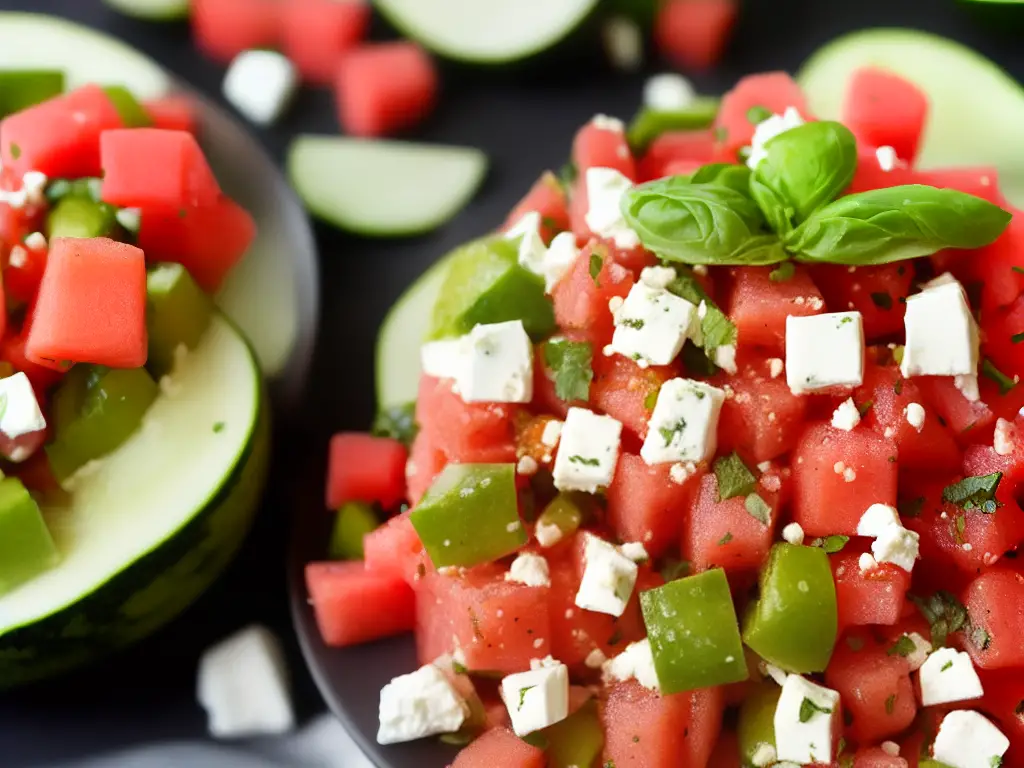
Combining Ingredients and Mixing
Ingredients:
- 4 cups cubed watermelon (seedless or seeds removed)
- 2 cups diced cucumber (English or seedless)
- 1/2 cup crumbled feta cheese
- 1/4 cup thinly sliced red onion
- 1/4 cup chopped fresh mint
- 1/4 cup chopped fresh basil
- 1/4 cup olive oil
- 2 tablespoons freshly squeezed lime juice
- Salt and black pepper, to taste
Instructions:
- Prepare the ingredients: Ensure that you have all the ingredients ready and properly measured. Make sure your watermelon is cubed, cucumber is diced, feta cheese is crumbled, red onion is thinly sliced, and fresh mint and basil are chopped.
- Combine the watermelon and cucumber: In a large mixing bowl, gently combine the cubed watermelon and diced cucumber. Make sure not to apply too much pressure to avoid crushing the watermelon pieces.
- Add the feta cheese: Sprinkle the crumbled feta cheese over the watermelon and cucumber mixture. Distribute the cheese evenly throughout the dish.
- Incorporate the red onion: Scatter the thinly sliced red onion across the salad, ensuring an even distribution.
- Add the fresh herbs: Sprinkle the chopped fresh mint and basil over the salad, making sure they are evenly dispersed.
- Mix the dressing: In a separate small bowl or measuring cup, combine the olive oil, freshly squeezed lime juice, salt, and black pepper. Whisk the mixture well to combine and emulsify the ingredients.
- Pour the dressing over the salad: Drizzle the dressing evenly over the watermelon salad, taking care to distribute it as evenly as possible.
- Gently mix the salad: Using a large spoon or salad tongs, carefully toss the salad to combine all the ingredients and coat them in the dressing. Make sure to be gentle while mixing to prevent bruising or crushing the watermelon and cucumber pieces.
- Taste and adjust seasoning: After mixing, taste the salad to see if it needs any additional salt or pepper. Adjust according to your taste preference.
- Serve immediately or chill: You can serve the watermelon salad immediately, or you may choose to let it chill in the refrigerator for about 15-30 minutes to allow the flavors to meld together. Enjoy your refreshing watermelon salad!
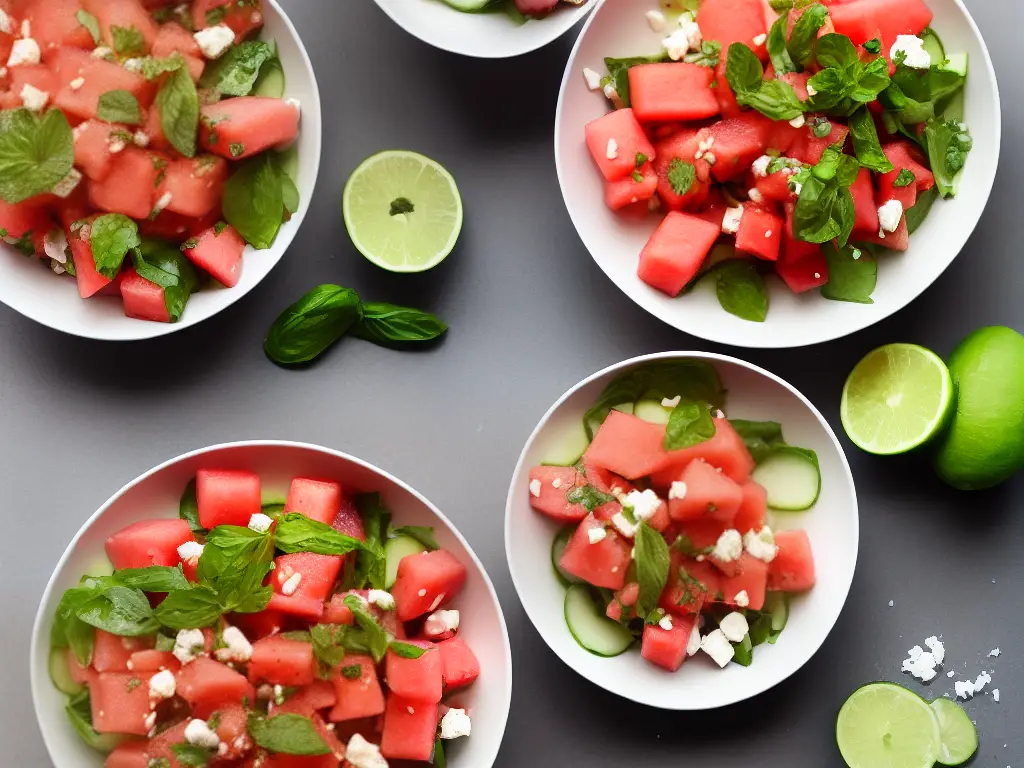
Preparing the Salad Dressing
A light and refreshing salad dressing is the perfect accompaniment for a watermelon salad. In this guide, we’ll give you instructions on how to prepare two different salad dressings – a simple citrus vinaigrette and a creamy yogurt-based dressing – to complement your watermelon salad.
Citrus Vinaigrette Dressing:
- 1/4 cup freshly squeezed lemon or lime juice
- 1/2 cup extra-virgin olive oil
- 1 tablespoon honey or maple syrup (optional, for a touch of sweetness)
- Salt and pepper, to taste
In a small mixing bowl or a jar with a lid, combine the lemon or lime juice, olive oil, and honey or maple syrup (if using). Whisk the mixture until well combined. Alternatively, if using a jar, cover with the lid and shake vigorously to emulsify the dressing. Taste the dressing and add salt and pepper to your liking. Set aside until you’re ready to dress the salad. You can store this vinaigrette in the refrigerator for up to a week in a sealed container. Shake or whisk again before use.
Creamy Yogurt-Based Dressing:
- 1/2 cup plain Greek yogurt
- 1/4 cup freshly squeezed lemon or lime juice
- 1/4 cup chopped fresh cilantro or mint (or a combination of both)
- 1 tablespoon honey or maple syrup (optional, for a touch of sweetness)
- Salt and pepper, to taste
In a small mixing bowl, combine the Greek yogurt, lemon or lime juice, chopped herbs, and honey or maple syrup (if using). Whisk the mixture until well combined and smooth. Taste the dressing and add salt and pepper to your liking. Set aside until you’re ready to dress the salad. This dressing can be stored in the refrigerator for up to 3 days in a sealed container.
When you’re ready to serve the watermelon salad, gently toss the watermelon and other ingredients with your chosen dressing until well coated. You can also drizzle the dressing on top of the salad if you prefer a lighter touch.
Image Description: A refreshing watermelon salad with feta cheese and mint leaves in a white bowl on a wooden table.
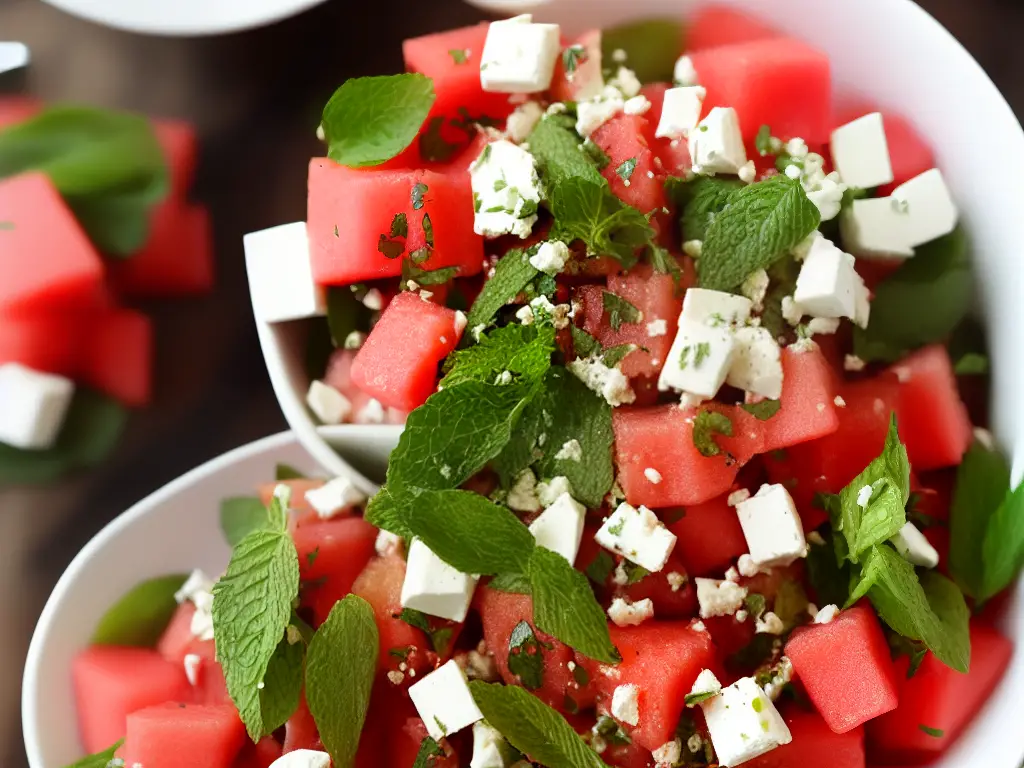
Taste Testing and Adjusting
In this guide, we will discuss the process of taste testing and adjusting a watermelon salad to achieve the perfect balance of flavors. This will help you create a delicious and refreshing salad that will impress your friends and family. Keep in mind that taste is subjective, and it’s essential to adjust the salad to your personal preferences.
Materials Needed:
- Prepared watermelon salad
- A clean fork or spoon
- Salt, pepper, and any additional desired seasonings
- Ingredients for the dressing (such as olive oil, vinegar, honey, or lime juice)
Step 1: Prepare the watermelon salad
Before you can begin taste testing, prepare your watermelon salad according to your chosen recipe. Common ingredients in a watermelon salad might include diced watermelon, crumbled feta cheese, thinly sliced red onion, chopped fresh mint, and arugula or other mixed greens. You can customize the salad to your personal preferences and dietary needs.
Step 2: Taste the salad
Using a clean fork or spoon, take a small bite of the salad, making sure to get a little bit of each ingredient on the fork. This will give you a good idea of the overall flavor balance. Pay attention to the sweetness of the watermelon, the saltiness of the feta, and the tartness of the dressing.
Step 3: Adjust seasoning
If you find that your salad needs more seasoning, feel free to add a pinch of salt, pepper, or other desired seasonings. It’s important to start with a small amount because you can always add more, but you can’t take it out if you over-season.
Step 4: Taste the dressing
If the salad still doesn’t taste quite right, the issue might be with the dressing. Taste the dressing on its own, or dip a piece of watermelon or feta in it to get a better sense of its flavor. If it’s too sweet, you could add more vinegar or lime juice for acidity. If it’s too tart, try adding a bit of honey or sugar to balance it out. If it’s too oily, consider adding more vinegar, lime juice, or other flavorful liquids to balance the oiliness.
Step 5: Re-mix and taste again
After making any adjustments to the seasoning or dressing, mix the salad thoroughly to ensure everything is evenly distributed. Take another bite, making sure to include all the ingredients again. Continue making small adjustments and re-tasting the salad until you achieve the perfect flavor balance.
Step 6: Serve and enjoy
Once you’re satisfied with the taste of your watermelon salad, it’s time to serve and enjoy! Remember, food tastes better when shared, so enjoy your delicious watermelon salad with friends and family.
Achieving the perfect balance of flavors in a watermelon salad is crucial for creating a delicious and refreshing dish. By following these simple steps for taste testing and adjusting, you’ll be able to create a watermelon salad that you and your guests will love. Remember, the key is to customize the salad to your personal preferences, and don’t be afraid to get creative with seasonings and dressings. Happy taste testing!
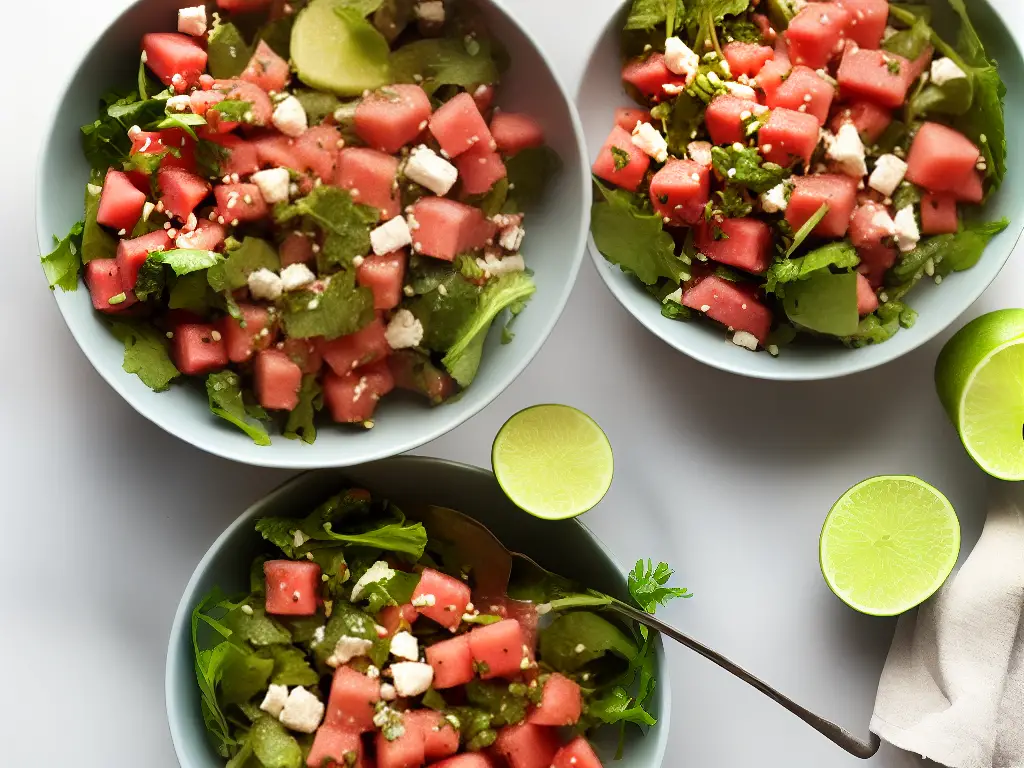
Plating and Garnishing
Begin by selecting an appropriate plate or serving platter for your watermelon salad. Ideally, choose a large, flat plate with a clean design or a solid color to showcase the vibrant colors and textures of your salad.
Before plating the salad, make sure all the ingredients are prepared and ready. Carefully cut the watermelon into bite-sized cubes or wedges, crumble or cube the feta cheese, and coarsely chop any fresh herbs you want to use for garnishing (such as mint, basil, or cilantro).
To begin plating your watermelon salad, start by layering a few pieces of lettuce or mixed greens on the plate. This will create a visually appealing base for your salad and elevate the other ingredients.
Next, arrange the watermelon pieces on top of the lettuce/greens, either by piling them up in a mound or arranging them in a circular or geometric pattern around the plate.
Sprinkle the crumbled or cubed feta cheese evenly over the watermelon pieces. You can also choose to place larger pieces of feta strategically around the plate for a more dramatic effect.
If you’re using a dressing or vinaigrette for your watermelon salad, drizzle it over the salad sparingly. You can use a spoon or a small squeeze bottle for precision.
Finally, scatter your chosen fresh herbs across the salad, either by sprinkling them or by arranging individual leaves or sprigs in a visually pleasing pattern.
For extra flair, you can add items such as thinly sliced red onions, small edible flowers, or even a final touch of freshly ground black pepper or a pinch of sea salt.
Once your watermelon salad is plated and garnished to your liking, serve it immediately to ensure the flavors and textures are at their best. Enjoy your refreshing, attractively presented watermelon salad!
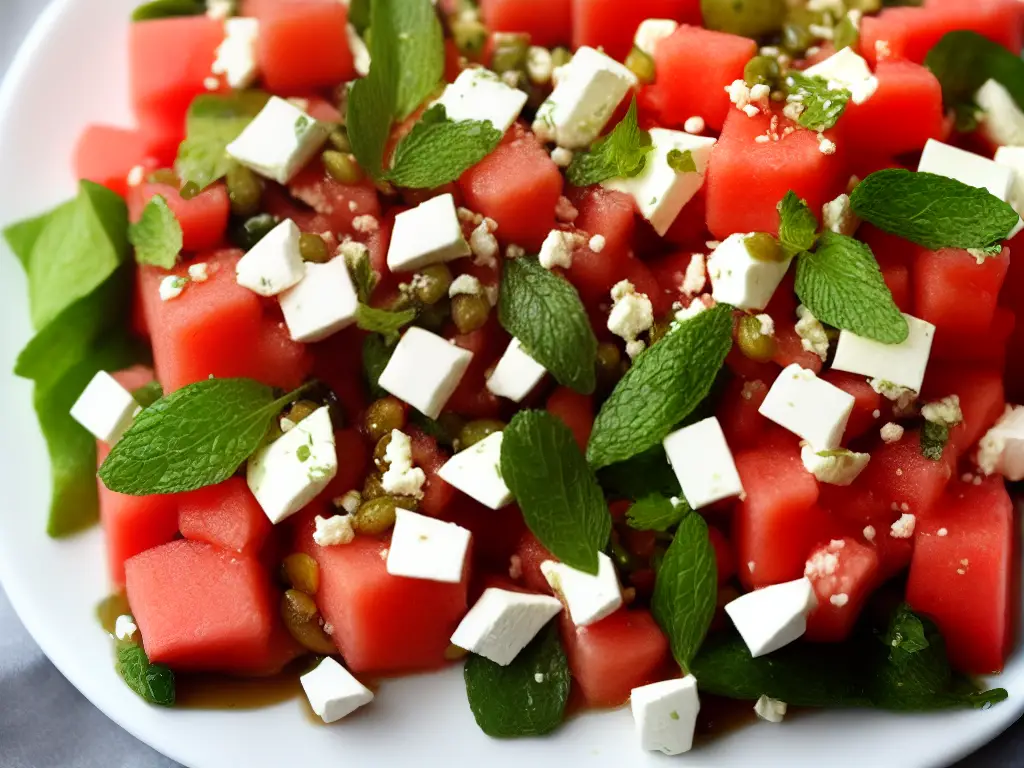
Storing and Serving
A refreshing watermelon salad is a delightful and nutritious addition to your meal. To maintain its delicious taste, proper storage and serving techniques are crucial. Following these simple tips will ensure your watermelon salad stays fresh and enjoyable for you and your guests.
Storing Your Watermelon Salad:
-
Keep it cold: Since watermelon salad has fresh ingredients, it is essential to keep the salad at a cold temperature. Store the salad in the refrigerator at a temperature below 40°F (4°C) to prevent bacteria growth and to help preserve the freshness of the ingredients.
-
Use an airtight container: To avoid cross-contamination and protect your salad from absorbing unwanted fridge odors, always store your salad in an airtight container. Airtight containers also help maintain the dish’s freshness by preventing excess moisture loss.
-
Don’t dress the salad ahead of time: If your watermelon salad recipe includes a dressing, avoid adding the dressing to the entire batch of salad before refrigerating. The dressing can make the salad ingredients soggy and less appealing. Instead, store the dressing separately in a smaller airtight container.
-
Avoid prolonged storage: Although properly stored watermelon salad can last up to 3 days in the refrigerator, consuming it within a day or two is recommended. The longer the salad sits, even in an airtight container, the less fresh and flavorful it becomes.
Serving Your Watermelon Salad:
-
Bring the salad to room temperature: Before serving, remove the salad from the refrigerator and let it sit for about 10-15 minutes at room temperature. This will help to enhance the flavors of the ingredients without making it too warm.
-
Dress the salad right before serving: If your watermelon salad recipe includes a dressing, make sure to mix it in just before serving the salad. This helps to avoid sogginess and allows your guests to enjoy the crisp, fresh ingredients.
-
Garnish for added appeal: Add a touch of visual appeal by garnishing the salad with fresh mint leaves, crumbled feta cheese, or a few thin slices of red onion.
-
Serve chilled: Although it’s important to let the salad sit at room temperature for a short time, it should still be served chilled. Use a chilled serving bowl to help maintain the crispness of the watermelon and other ingredients.
By following these storing and serving tips, you’ll be able to enjoy your watermelon salad with optimal freshness and flavor. Enjoy your refreshing and delicious salad with friends and family, knowing you’ve taken the steps to preserve its quality.
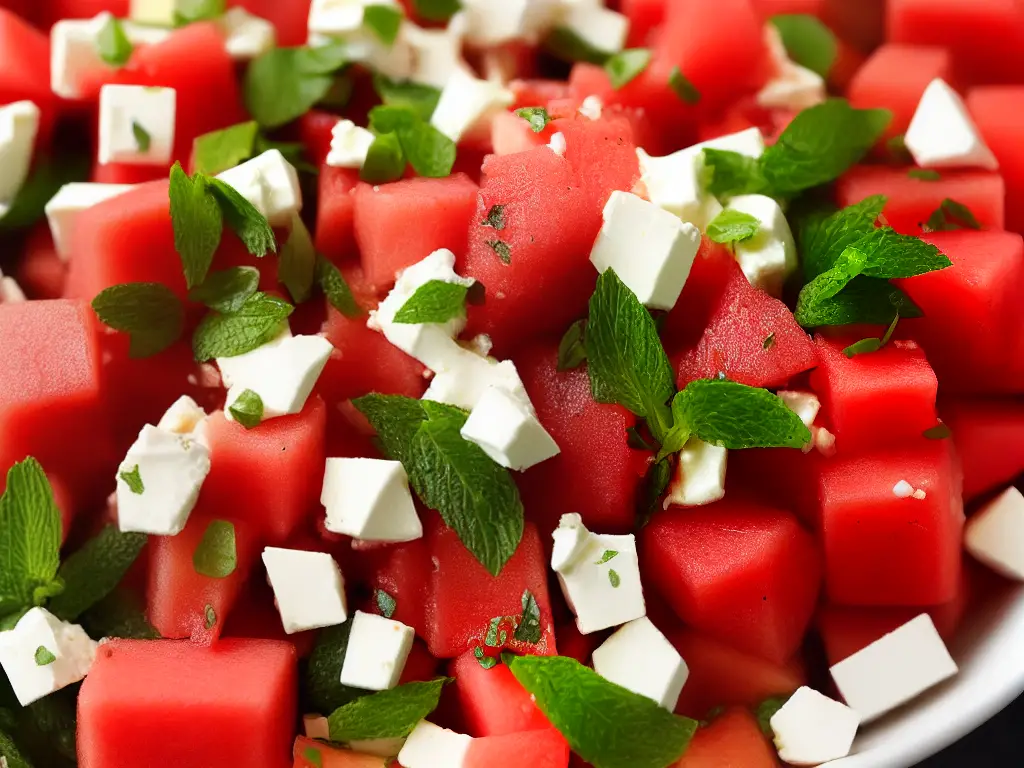
Exploring Variations
Begin your research: Start by browsing through various food websites, blogs, cookbooks, and magazines that offer a variety of watermelon salad recipes. You can also watch cooking videos on platforms like YouTube for visual demonstrations of different combinations and techniques. Take note of the main ingredients and flavors in each recipe, as well as any unique additions or twists that catch your eye.
Create a list of ingredients and flavors: Based on your research, make a list of common ingredients and flavors found in watermelon salad recipes. This may include the watermelon itself, other fruits, vegetables, herbs, cheeses, nuts, dressing ingredients, seasonings, and garnishes.
Experiment with unique combinations: Use your list to mix and match ingredients, creating exciting and unusual combinations for your watermelon salad. For instance, if you notice a recipe that features feta cheese and another one that incorporates blueberries, consider combining both in your salad for a unique flavor mix.
Seek inspiration from other cuisines: Many cultures have their unique takes on classic dishes, and you can learn a lot from them. Look into international interpretations of watermelon salad for new ideas on ingredient pairings and flavor profiles. For instance, you could explore Mediterranean, Thai, or Caribbean variations of watermelon salads.
Focus on seasonal ingredients: Keep in mind that, like watermelon, many fruits, vegetables, and herbs are seasonal – meaning they have their peak of ripeness and flavor at specific times of the year. By incorporating other seasonal ingredients into your watermelon salad, you can create a dish that truly captures the essence of the season.
Experiment with texture: Watermelon is inherently crunchy, juicy, and somewhat soft. To create a more interesting dish, consider the texture of each ingredient you add. For instance, you could add a variety of crunchy, crispy, or chewy elements (like nuts, seeds, or croutons) to your salad to offer a contrast to the watermelon’s texture.
Vary the dressing: While many watermelon salad recipes use a light vinegar-based dressing, don’t be afraid to experiment with different types of dressings, marinades, or sauces. Try using light cream-based dressings, citrusy vinaigrettes, or even incorporating yogurt for a tangy twist.
Use a variety of herbs and spices: Herbs and spices can take your watermelon salad to new heights. Examples of herbs and spices that pair well with watermelon include mint, basil, cilantro, pepper, and chili. Use these ingredients to create exciting new flavor combinations in your salads.
Get creative with presentation: A visually appealing dish can be even more enjoyable to eat. Experiment with different ways of presenting your watermelon salad, such as arranging the ingredients in a specific pattern, layering them, or using unique serving dishes or platters.
Adjust the recipe to suit your taste: As you try out various watermelon salad recipes and combinations, don’t be afraid to adjust the ingredients and flavors to your liking. Your taste buds are the ultimate judge of what makes a delicious and satisfying watermelon salad. Remember that exploring different variations is all about discovering new and delicious ways to enjoy this classic summer dish. Enjoy the process!
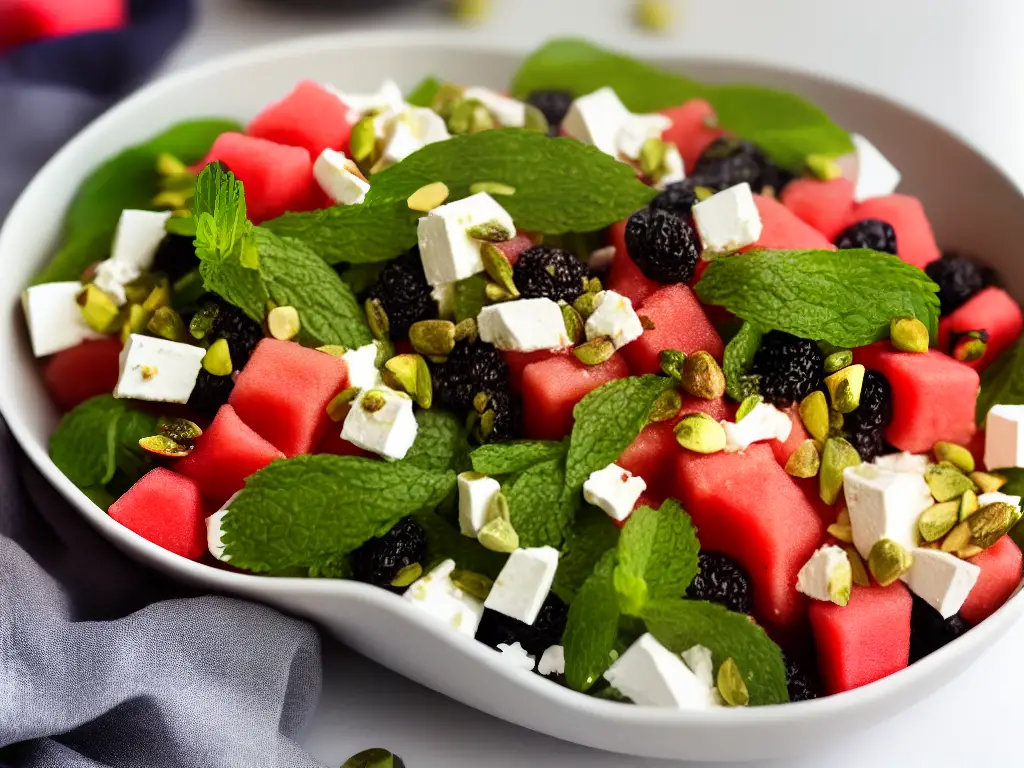
Once you’ve mastered the basic techniques for creating your delectable watermelon salad, don’t be afraid to venture into new territory. Explore different combinations and flavors to create a unique and personalized dish that will delight your taste buds. Remember that practice makes perfect, so don’t get discouraged if your first attempt isn’t perfect. Enjoy the journey and open yourself up to the infinite possibilities that come with mastering the art of watermelon salad.